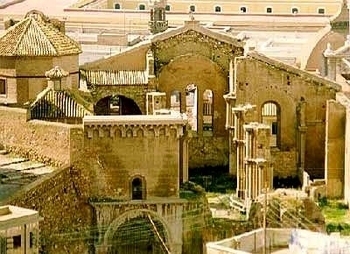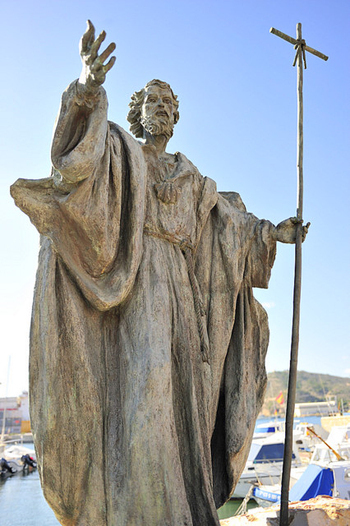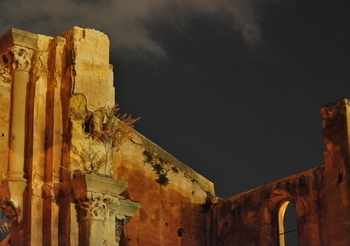Catedral Vieja de Santa María, the ruined cathedral of Cartagena
Cartagena The Old Cathedral of Cartagena
Cartagena Catedral Vieja de Santa María
Click for map; Catedral Vieja Cartagena ( shown on map behind La Catedral restaurant)
Traditionally the Catedral Vieja de Santa María is considered to be in the  location of the first church founded by the Apostle Saint James, known in Spain, as Santiago, who landed in Cartagena in the early part of the 1st century AD on a mission to spread the word of Christianity throughout Spain.
location of the first church founded by the Apostle Saint James, known in Spain, as Santiago, who landed in Cartagena in the early part of the 1st century AD on a mission to spread the word of Christianity throughout Spain.
A statue in the port commemorates his landing and from here the Region has created its own pilgrimage route, their own Camino de Santiago, which leads to Caravaca de la Cruz.
 Cartagena was occupied by the Moors between the 8th and 13th centuries, but became part of the Christian holdings in Spain in 1243 when the Kingdom of Murcia was taken by the young Prince Alfonso, who went on to become one of Spain´s best known monarchs, Alfonso X, El Sabio. Although he had taken Murcia, the Moors in Cartagena refused to accept the treaty and rebelled, so it wasn´t until 1245 that he was able to bring an army and a navy to attack the City and formally incorporate it into his territories.
Cartagena was occupied by the Moors between the 8th and 13th centuries, but became part of the Christian holdings in Spain in 1243 when the Kingdom of Murcia was taken by the young Prince Alfonso, who went on to become one of Spain´s best known monarchs, Alfonso X, El Sabio. Although he had taken Murcia, the Moors in Cartagena refused to accept the treaty and rebelled, so it wasn´t until 1245 that he was able to bring an army and a navy to attack the City and formally incorporate it into his territories.
He nominated Cartagena to be the seat of the Christian Diocese covering the region, the diocese of the Bishop of Cartagena, naming Brother Pedro Gallego as the Confessor of the King and building a new cathedral in the location, giving Cartagena the  right to collect the tithes due to the church. In 1291, however, the seat of the diocese was relocated to Murcia, where it remains today.
right to collect the tithes due to the church. In 1291, however, the seat of the diocese was relocated to Murcia, where it remains today.
During the 14th century the city was fortified, a defensive wall encompassing the Cathedral and linking the Castillo de la Concepción.
There are still traces of this original building in what remains today, with columns and chapels still visible, but significant rebuilding work was undertaken in the 16th century, Juan Bautista Antonelli building the Capilla de los Cuatro Santos, which held the image of Nuestra Señora del Rosell, who at that point was the patron of the City.
A century later in 1691 the Capilla del Cristo del Socorro was added by Pedro de Colón y Portugal, Duke of Veragua who added a dome, redecorating internally and externally with stucco and plaster.
The cathedral was competely remodelled and restored in 1902 by the Architect Victor Beltrí, finished in the neoromantic style. There are many buildings designed by this significant architect throughout the City of Cartagena, and in 2012 the City commemorates the 100th anniversary of his death.
 Sadly, however, during the Spanish Civil War of 1936-39 the Cathedral was virtually destroyed by the aerial bombardments to which the city was subjected, holding out against the forces of Franco and operating as both a munitions manufacturing base and supply chain for the loyalists fighting his forces. A good place to discover more about these horrific bombardments is the Civil war Air raid shelter (click Refugio de la Guerra Civil Cartagena), which is open to the public and is a very interesting place for those who wish to really understand what Cartagena has been through as a City. A small part of the Cathedral was used for religious ceremonies up until the late part of the 20th century although archaeological excavations began in 1958.
Sadly, however, during the Spanish Civil War of 1936-39 the Cathedral was virtually destroyed by the aerial bombardments to which the city was subjected, holding out against the forces of Franco and operating as both a munitions manufacturing base and supply chain for the loyalists fighting his forces. A good place to discover more about these horrific bombardments is the Civil war Air raid shelter (click Refugio de la Guerra Civil Cartagena), which is open to the public and is a very interesting place for those who wish to really understand what Cartagena has been through as a City. A small part of the Cathedral was used for religious ceremonies up until the late part of the 20th century although archaeological excavations began in 1958.
The chapel built in 1691 by the Duke of Veragua belonged to the Cofradía del Cristo del Socorro who still used the runis of it for various celebrations until the 1990´s the figure of Christ leaving from the Cathedral ruins during Semana Santa up until 12 years ago.
The Cathedral is used nowadays as a venue during the Cartagena Mar de Músicas festival, an atmospheric and intimate setting for concerts.
The structure of the Cathedral is entwined with that of the Roman Theatre Museum,( Click Roman Theatre Museum Cartagena) incorporating remains of the Theatre within its structure, and roman mosaic has also been discovered in an underground crypt.
It has to be remembered that by the time the 13th century Cathedral was built, the Roman theatre was already buried beneath an arab district of the City, stone from the theatre having been reused in various projects after the city was sacked and destroyed by the Visigoths in the 5th century.
 The original structure of the theatre formed part of the line of the fortifications, and what we see today as the theatre was in fact only part of the enormous complex which stretched out right across where the Town hall is today. As a result of this, part of the Roman Theater lies below the Cathedral, and visitors to the Roman Theatre Museum actually pass through the foundations of the Cathedral as part of their journey to the ampitheatre itself, also viewing the ruins of a Roman Villa which was knocked down to make way for the Theatre to be built, so history and centuries entwine in this whole complex.
The original structure of the theatre formed part of the line of the fortifications, and what we see today as the theatre was in fact only part of the enormous complex which stretched out right across where the Town hall is today. As a result of this, part of the Roman Theater lies below the Cathedral, and visitors to the Roman Theatre Museum actually pass through the foundations of the Cathedral as part of their journey to the ampitheatre itself, also viewing the ruins of a Roman Villa which was knocked down to make way for the Theatre to be built, so history and centuries entwine in this whole complex.
Extensive archaeological explorations have been carried out during the last 30 years, gradually uncovering the history which lies beneath and around, the cathedral.
In May 2011 it was announced that funds had been approved for the restoration of part of the old Cathedral, which would be recuperated to enable it to function once again as a religious building.




 location of the first church founded by the Apostle Saint James, known in Spain, as Santiago, who landed in Cartagena in the early part of the 1st century AD on a mission to spread the word of Christianity throughout Spain.
location of the first church founded by the Apostle Saint James, known in Spain, as Santiago, who landed in Cartagena in the early part of the 1st century AD on a mission to spread the word of Christianity throughout Spain. Cartagena was occupied by the Moors between the 8th and 13th centuries, but became part of the Christian holdings in Spain in 1243 when the Kingdom of Murcia was taken by the young Prince Alfonso, who went on to become one of Spain´s best known monarchs, Alfonso X, El Sabio. Although he had taken Murcia, the Moors in Cartagena refused to accept the treaty and rebelled, so it wasn´t until 1245 that he was able to bring an army and a navy to attack the City and formally incorporate it into his territories.
Cartagena was occupied by the Moors between the 8th and 13th centuries, but became part of the Christian holdings in Spain in 1243 when the Kingdom of Murcia was taken by the young Prince Alfonso, who went on to become one of Spain´s best known monarchs, Alfonso X, El Sabio. Although he had taken Murcia, the Moors in Cartagena refused to accept the treaty and rebelled, so it wasn´t until 1245 that he was able to bring an army and a navy to attack the City and formally incorporate it into his territories. right to collect the tithes due to the church. In 1291, however, the seat of the diocese was relocated to Murcia, where it remains today.
right to collect the tithes due to the church. In 1291, however, the seat of the diocese was relocated to Murcia, where it remains today. Sadly, however, during the Spanish Civil War of 1936-39 the
Sadly, however, during the Spanish Civil War of 1936-39 the  The original structure of the theatre formed part of the line of the fortifications, and what we see today as the theatre was in fact only part of the enormous complex which stretched out right across where the Town hall is today. As a result of this, part of the Roman Theater lies below the Cathedral, and visitors to the Roman Theatre Museum actually pass through the foundations of the Cathedral as part of their journey to the ampitheatre itself, also viewing the ruins of a Roman Villa which was knocked down to make way for the Theatre to be built, so history and centuries entwine in this whole complex.
The original structure of the theatre formed part of the line of the fortifications, and what we see today as the theatre was in fact only part of the enormous complex which stretched out right across where the Town hall is today. As a result of this, part of the Roman Theater lies below the Cathedral, and visitors to the Roman Theatre Museum actually pass through the foundations of the Cathedral as part of their journey to the ampitheatre itself, also viewing the ruins of a Roman Villa which was knocked down to make way for the Theatre to be built, so history and centuries entwine in this whole complex.






